哒螨灵,Pyridaben,分析标准品,1000μg/ml in methanol
产品编号:Bellancom-YE106569| CAS NO:96489-71-3| MDL NO:MFCD00274601| 分子式:C19H25ClN2OS| 分子量:364.93
吡达本是一种METI杀螨剂,可抑制复合物I(METI;大鼠脑线粒体中Ki=0.36 nmol/mg蛋白质)的线粒体电子传递。吡达本对多种螨虫有活性,分别以25、100和200毫克/立方米的剂量通过滤纸接触给药,可导致马来丝虫、法氏锥虫和腐败T.的100%死亡率。
本网站销售的所有产品仅用于工业应用或者科学研究等非医疗目的,不可用于人类或动物的临床诊断或者治疗,非药用,非食用,
| 产品名称 | 哒螨灵 | ||||||||||||||||
|---|---|---|---|---|---|---|---|---|---|---|---|---|---|---|---|---|---|
| 英文名称 | Pyridaben | ||||||||||||||||
| CAS编号 | 96489-71-3 | ||||||||||||||||
| 产品描述 | 吡达本是一种METI杀螨剂,可抑制复合物I(METI;大鼠脑线粒体中Ki=0.36 nmol/mg蛋白质)的线粒体电子传递。吡达本对多种螨虫有活性,分别以25、100和200毫克/立方米的剂量通过滤纸接触给药,可导致马来丝虫、法氏锥虫和腐败T.的100%死亡率。 | ||||||||||||||||
| 产品熔点 | 111-112ºC | ||||||||||||||||
| 产品沸点 | 429.9ºC at 760 mmHg | ||||||||||||||||
| 产品密度 | 1.12 g/cm3 | ||||||||||||||||
| 产品闪点 | 213.8ºC | ||||||||||||||||
| 精确质量 | 364.13800 | ||||||||||||||||
| PSA | 60.19000 | ||||||||||||||||
| LogP | 5.24150 | ||||||||||||||||
| 外观性状 | 白色固体 | ||||||||||||||||
| 折射率 | 1.564 | ||||||||||||||||
| 溶解性数据 | In Vitro:
DMSO : 50 mg/mL (137.01 mM; Need ultrasonic) 配制储备液
*
请根据产品在不同溶剂中的溶解度选择合适的溶剂配制储备液;一旦配成溶液,请分装保存,避免反复冻融造成的产品失效。 In Vivo:
请根据您的实验动物和给药方式选择适当的溶解方案。以下溶解方案都请先按照 In Vitro 方式配制澄清的储备液,再依次添加助溶剂:
——为保证实验结果的可靠性,澄清的储备液可以根据储存条件,适当保存;体内实验的工作液,建议您现用现配,当天使用;
以下溶剂前显示的百
*以上所有助溶剂都可在西域网站选购。
| ||||||||||||||||
| 稳定性 | 常温常压下稳定,避免与强氧化剂接触。对眼和皮肤无刺激性,对豚鼠皮肤无致敏性。 | ||||||||||||||||
| 储存条件 | 密封储存,储存于阴凉、干燥的库房。远离热源,火焰。 |
相关文档
化学品安全说明书(MSDS)
下载MSDS质检证书(COA)
相关产品
-
CAS号:96489-71-3

哒螨灵
¥84.00
-
CAS号:96489-71-3

哒螨灵
¥159.00
-
CAS号:96489-71-3

哒螨灵
¥159.00
-
CAS号:96489-71-3

哒螨灵
¥150.00
-
CAS号:96489-71-3

哒螨灵
¥120.00
-
CAS号:96489-71-3

丙酮中哒螨灵溶液标准物质
¥84.00
-
CAS号:96489-71-3
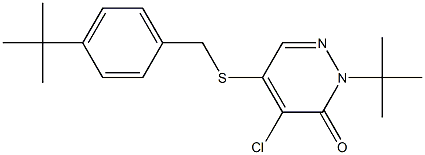
哒螨灵, 100μg/mL,U...
¥199.00
-
CAS号:96489-71-3
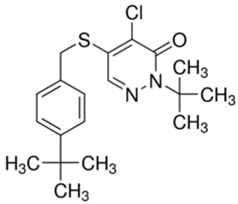
哒螨灵
¥980.00
-
CAS号:96489-71-3
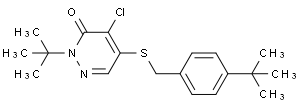
哒螨灵
¥336.00
-
CAS号:96489-71-3

哒螨灵
¥436.00
-
CAS号:96489-71-3

哒螨灵
¥436.00
-
CAS号:96489-71-3

哒螨灵
¥168.00
| 符号 |
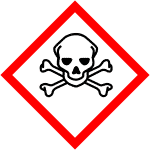
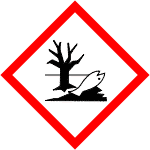
GHS06, GHS09 |
|---|---|
| 信号词 | Danger |
| 危害声明 | H301-H331-H410 |
| 警示性声明 | P261-P273-P301 + P310-P311-P501 |
| 个人防护装备 | Eyeshields;Faceshields;Gloves;type P2 (EN 143) respirator cartridges |
| 危害码 (欧洲) | T:Toxic;N:Dangerousfortheenvironment; |
| 风险声明 (欧洲) | R23/25;R50/53 |
| 安全声明 (欧洲) | S36/37-S45-S60-S61 |
| 危险品运输编码 | UN 3077 |
| RTECS号 | UR6149000 |
| 包装等级 | II |
| 危险类别 | 6.1(a) |
| 海关编码 | 2933399027 |
|
Section1. IDENTIFICATION OF THE SUBSTANCE/MIXTURE Product identifiers Product name: Pyridaben CAS-No.: 96489-71-3 Relevant identified uses of the substance or mixture and uses advised against Identified uses: Laboratory chemicals, Manufacture of substances Section2. HAZARDS IDENTIFICATION Classification of the substance or mixture Classification according to Regulation (EC) No 1272/2008 [EU-GHS/CLP] Acute toxicity, Inhalation (Category 3) Acute toxicity, Oral (Category 3) Acute aquatic toxicity (Category 1) Chronic aquatic toxicity (Category 1) Classification according to EU Directives 67/548/EEC or 1999/45/EC Toxic by inhalation and if swallowed. Very toxic to aquatic organisms, may cause long-term adverse effects in the aquatic environment. Label elements Labelling according Regulation (EC) No 1272/2008 [CLP] Pictogram Signal wordDanger Hazard statement(s) H301Toxic if swallowed. H331Toxic if inhaled. H410Very toxic to aquatic life with long lasting effects. Precautionary statement(s) P261Avoid breathing dust/ fume/ gas/ mist/ vapours/ spray. P273Avoid release to the environment. P301 + P310IF SWALLOWED: Immediately call a POISON CENTER or doctor/ physician. P311Call a POISON CENTER or doctor/ physician. P501Dispose of contents/ container to an approved waste disposal plant. Supplemental Hazardnone Statements According to European Directive 67/548/EEC as amended. Hazard symbol(s) R-phrase(s) R23/25Toxic by inhalation and if swallowed. R50/53Very toxic to aquatic organisms, may cause long-term adverse effects in the aquatic environment. S-phrase(s) S36/37Wear suitable protective clothing and gloves. S45In case of accident or if you feel unwell, seek medical advice immediately (show the label where possible). S60This material and its container must be disposed of as hazardous waste. S61Avoid release to the environment. Refer to special instructions/ Safety data sheets. Other hazards - none Section3. COMPOSITION/INFORMATION ON INGREDIENTS Substances Formula: C19H25ClN2OS Molecular Weight: 364,93 g/mol ComponentConcentration 2-tert-Butyl-5-(4-tert-butylbenzylthio)-4-chloro-pyridazine-3(2H)-one CAS-No.96489-71-3- EC-No.405-700-3 Index-No.613-149-00-7 Section4. FIRST AID MEASURES Description of first aid measures General advice Consult a physician. Show this safety data sheet to the doctor in attendance. If inhaled If breathed in, move person into fresh air. If not breathing, give artificial respiration. Consult a physician. In case of skin contact Wash off with soap and plenty of water. Take victim immediately to hospital. Consult a physician. In case of eye contact Flush eyes with water as a precaution. If swallowed Never give anything by mouth to an unconscious person. Rinse mouth with water. Consult a physician. Most important symptoms and effects, both acute and delayed Indication of any immediate medical attention and special treatment needed no data available Section5. FIREFIGHTING MEASURES Extinguishing media Suitable extinguishing media Use water spray, alcohol-resistant foam, dry chemical or carbon dioxide. Special hazards arising from the substance or mixture Carbon oxides, nitrogen oxides (NOx), Sulphur oxides, Hydrogen chloride gas Nature of decomposition products not known. Carbon oxides, nitrogen oxides (NOx), Sulphur oxides, Hydrogen chloride gas Advice for firefighters Wear self contained breathing apparatus for fire fighting if necessary. Further information no data available Section6. ACCIDENTAL RELEASE MEASURES Personal precautions, protective equipment and emergency procedures Wear respiratory protection. Avoid dust formation. Avoid breathing vapors, mist or gas. Ensure adequate ventilation. Evacuate personnel to safe areas. Avoid breathing dust. Environmental precautions Prevent further leakage or spillage if safe to do so. Do not let product enter drains. Discharge into the environment must be avoided. Methods and materials for containment and cleaning up Pick up and arrange disposal without creating dust. Sweep up and shovel. Keep in suitable, closed containers for disposal. Reference to other sections For disposal see section 13. Section7. HANDLING AND STORAGE Precautions for safe handling Avoid contact with skin and eyes. Avoid formation of dust and aerosols. Provide appropriate exhaust ventilation at places where dust is formed. Conditions for safe storage, including any incompatibilities Store in cool place. Keep container tightly closed in a dry and well-ventilated place. Specific end uses no data available Section8. EXPOSURE CONTROLS/PERSONAL PROTECTION Control parameters Components with workplace control parameters Exposure controls Appropriate engineering controls Avoid contact with skin, eyes and clothing. Wash hands before breaks and immediately after handling the product. Personal protective equipment Eye/face protection Face shield and safety glasses Use equipment for eye protection tested and approved under appropriate government standards such as NIOSH (US) or EN 166(EU). Skin protection Handle with gloves. Gloves must be inspected prior to use. Use proper glove removal technique (without touching glove's outer surface) to avoid skin contact with this product. Dispose of contaminated gloves after use in accordance with applicable laws and good laboratory practices. Wash and dry hands. The selected protective gloves have to satisfy the specifications of EU Directive 89/686/EEC and the standard EN 374 derived from it. Body Protection Complete suit protecting against chemicals, The type of protective equipment must be selected according to the concentration and amount of the dangerous substance at the specific workplace. Respiratory protection Where risk assessment shows air-purifying respirators are appropriate use a full-face particle respirator type N99 (US) or type P2 (EN 143) respirator cartridges as a backup to engineering controls. If the respirator is the sole means of protection, use a full-face supplied air respirator. Use respirators and components tested and approved under appropriate government standards such as NIOSH (US) or CEN (EU). Section9. PHYSICAL AND CHEMICAL PROPERTIES Information on basic physical and chemical properties a) AppearanceForm: solid b) Odourno data available c) Odour Thresholdno data available d) pHno data available e) Melting point/freezingno data available point f) Initial boiling point and no data available boiling range g) Flash pointno data available h) Evaporation rateno data available i) Flammability (solid, gas) no data available j) Upper/lowerno data available flammability or explosive limits k) Vapour pressureno data available l) Vapour densityno data available m) Relative densityno data available n) Water solubilityno data available o) Partition coefficient: n- no data available octanol/water p) Autoignitionno data available temperature q) Decompositionno data available temperature r) Viscosityno data available s) Explosive propertiesno data available t) Oxidizing propertiesno data available Other safety information no data available Section10. STABILITY AND REACTIVITY Reactivity no data available Chemical stability no data available Possibility of hazardous reactions no data available Conditions to avoid no data available Incompatible materials Strong oxidizing agents Hazardous decomposition products Other decomposition products - no data available Section11. TOXICOLOGICAL INFORMATION Information on toxicological effects Acute toxicity LD50 Oral - mouse - 205 mg/kg Remarks: Behavioral:Somnolence (general depressed activity). Respiratory disorder Skin and Appendages: Other: Hair. LC50 Inhalation - rat - 620 mg/m3 LD50 Dermal - rabbit - > 2.000 mg/kg Skin corrosion/irritation no data available Serious eye damage/eye irritation no data available Respiratory or skin sensitization no data available Germ cell mutagenicity no data available Carcinogenicity IARC:No component of this product present at levels greater than or equal to 0.1% is identified as probable, possible or confirmed human carcinogen by IARC. Reproductive toxicity Reproductive toxicity - rat - Oral Maternal Effects: Other effects. Effects on Embryo or Fetus: Extra embryonic structures (e.g., placenta, umbilical cord). Effects on Embryo or Fetus: Fetotoxicity (except death, e.g., stunted fetus). Specific target organ toxicity - single exposure no data available Specific target organ toxicity - repeated exposure no data available Aspiration hazard no data available Potential health effects Inhalation Toxic if inhaled. May cause respiratory tract irritation. IngestionToxic if swallowed. Skin May be harmful if absorbed through skin. May cause skin irritation. EyesMay cause eye irritation. Additional Information RTECS: UR6149000 Section12. ECOLOGICAL INFORMATION Toxicity Toxicity to fishLC50 - Oncorhynchus mykiss (rainbow trout) - 0,72 µg/l - 96,0 h Toxicity to daphnia and EC50 - Daphnia magna (Water flea) - 0,53 µg/l - 48 h other aquatic invertebrates Persistence and degradability no data available Bioaccumulative potential no data available Mobility in soil no data available Results of PBT and vPvB assessment no data available Other adverse effects Very toxic to aquatic life with long lasting effects. Section13. DISPOSAL CONSIDERATIONS Waste treatment methods Product Offer surplus and non-recyclable solutions to a licensed disposal company. Dissolve or mix the material with a combustible solvent and burn in a chemical incinerator equipped with an afterburner and scrubber. Contaminated packaging Dispose of as unused product. Section14. TRANSPORT INFORMATION UN number ADR/RID: 3077IMDG: 3077IATA: 3077 UN proper shipping name ADR/RID: ENVIRONMENTALLY HAZARDOUS SUBSTANCE, SOLID, N.O.S. (2-tert-Butyl-5-(4-tert- butylbenzylthio)-4-chloro-pyridazine-3(2H)-one) IMDG: ENVIRONMENTALLY HAZARDOUS SUBSTANCE, SOLID, N.O.S. (2-tert-Butyl-5-(4-tert- butylbenzylthio)-4-chloro-pyridazine-3(2H)-one) IATA:Environmentally hazardous substance, solid, n.o.s. (2-tert-Butyl-5-(4-tert-butylbenzylthio)-4- chloro-pyridazine-3(2H)-one) Transport hazard class(es) ADR/RID: 9IMDG: 9IATA: 9 Packaging group ADR/RID: IIIIMDG: IIIIATA: III Environmental hazards ADR/RID: yesIMDG Marine pollutant: yesIATA: yes Special precautions for user Further information EHS-Mark required (ADR 2.2.9.1.10, IMDG code 2.10.3) for single packagings and combination packagings containing inner packagings with Dangerous Goods > 5L for liquids or > 5kg for solids. Section15. REGULATORY INFORMATION This safety datasheet complies with the requirements of Regulation (EC) No. 1907/2006. Safety, health and environmental regulations/legislation specific for the substance or mixture no data available Chemical Safety Assessment no data available Section16. OTHER INFORMATION Further information Copyright 2012 Co. LLC. License granted to make unlimited paper copies for internal use only. The above information is believed to be correct but does not purport to be all inclusive and shall be used only as a guide. The information in this document is based on the present state of our knowledge and is applicable to the product with regard to appropriate safety precautions. It does not represent any guarantee of the properties of the product. Corporation and its Affiliates shall not be held liable for any damage resulting from handling or from contact with the above product. See and/or the reverse side of invoice or packing slip for additional terms and conditions of sale. |
|
~85% 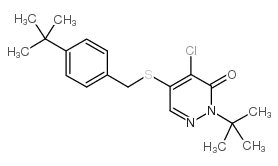
96489-71-3 |
| 文献:Nissan Chemical Industries Patent: US4877787 A1, 1989 ; |
|
~% 
96489-71-3 |
| 文献:US2005/191238 A1, ; Page/Page column 50 ; |
| 上游产品 3 | |
|---|---|
| 下游产品 0 | |

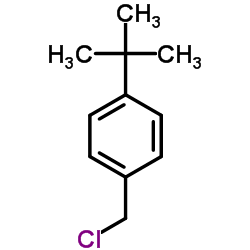
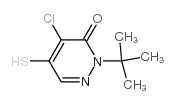
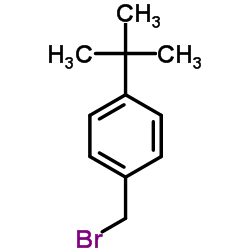





 浙公网安备 33010802013016号
浙公网安备 33010802013016号